July 2024
Where do I start? A few days ago I was touring Buckingham Palace with my friend Susan (no photos allowed). I was absolutely gobsmacked by the East Wing (a tour you need to sign up for weeks in advance; thank you, Susan). As I kept attempting to pick my jaw up from the floor, Susan said if I liked this, I must see Brighton, as everything in the East Wing originally came from there. So this is our day in Brighton and the Royal Pavillion.
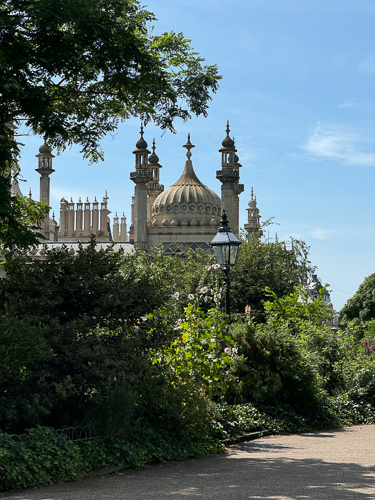
The exterior of the pavilion and its Indo-Islamic influence is the beginning of the building’s dichotomy.
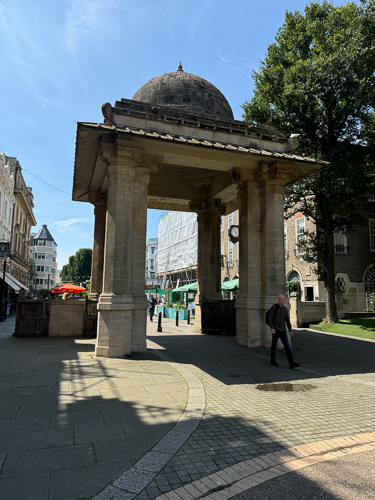
The India Gate
This dichotomy is echoed later in history by the installation of the India Gate. The India Gate is a memorial given to Brighten by the people of India to commemorate the Indian soldiers who passed through Brighton and Hove hospitals during the First World War (1914 – 1918). From 1914 to 1916, the Royal Pavillion was used for Indian soldiers who had been wounded on the battlefields of the Western Front. From 1916 to 1920, it was used as a hospital for British troops who had lost arms or legs in the war.
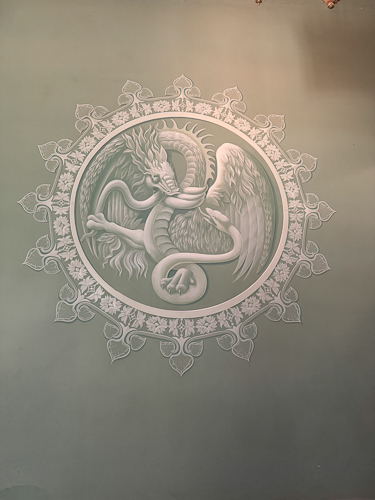
I ran into this description of the Royal Pavillion. It probably best sets up what I am about to show you: This Chinese-style interior belongs to a quintessentially Romantic piece of architecture…Silly, charming, witty, light-hearted, extravagant, gloriously eccentric, decadent, childish, painfully vulgar, socially irresponsible, a piece of outrageous folly and a stylistic phantasmagoria, the Pavilion is a flight of Romantic fancy, comparable in its impulse to Samuel Taylor Coleridge’s poem ‘Kubla Khan’.”
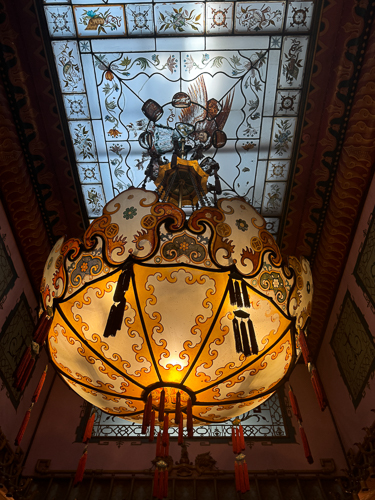
The Royal Pavillion came into existence thanks to The Prince of Wales, who later became Geroge IV. That is the last of the royal lineage you will get from me.
But I did mention the East Wing of Buckingham Palace. Queen Victoria found Brighton too “exposed” and sold the palace. As she thought it would be torn down, she stripped it bare of absolutely everything, including the wallpaper.
However, the town didn’t tear it down. Instead, they turned it into government offices. In 1920, a restoration program funded by a government settlement for the damage done during the war began. This was further boosted when Queen Mary returned original decorations, including furniture that had remained at Buckingham Palace. Queen Elizabeth also gave objects to the pavilion on permanent loan. And yet 20% of the collection still remains in Buckingham Palace, making the East Wing as spectacular as it is today.
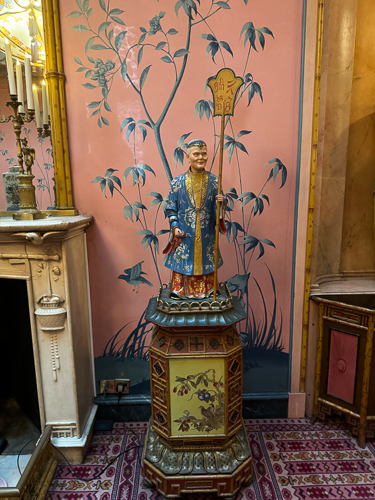
So, back to the building. Between 1815 and 1822, the designer John Nash designed the exterior of the building and its Indo-Islamic feel.
At the same time, the designers Frederick Crace and Robert Jones were employed to work on the interior of the Pavilion. They did so in the chinoiserie style. Thus, the dichotomy.
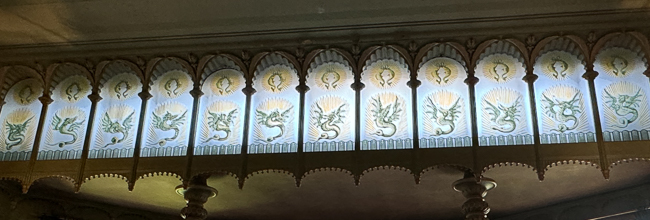
You enter the front door in what had been a lovely entry but now serves as a ticket area and gathering space. However, the glass window with its dragons tells you the Asian influence you are about to encounter.
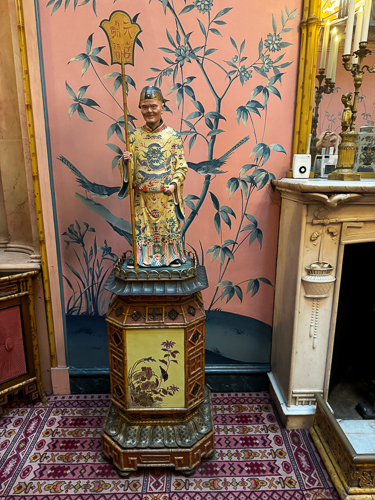
As you enter the long hall, you are greeted by several of these “Chinese” characters with Western features. (they are actually bobbleheads). To understand the Western features, one must understand Chinoiserie and the trade routes of the time. In the eighteenth century, as the East India Company increased its trade with China, Chinoiserie became a cross-cultural phenomenon between Asia and Europe. Given the rarity and high price of East-Asian-made products, European craftsmen designed and made decorative objects mimicking Chinese motifs, sadly without much authenticity. Notice the wallpaper in the background. It is the English idea of bamboo at the time, flowering to boot.
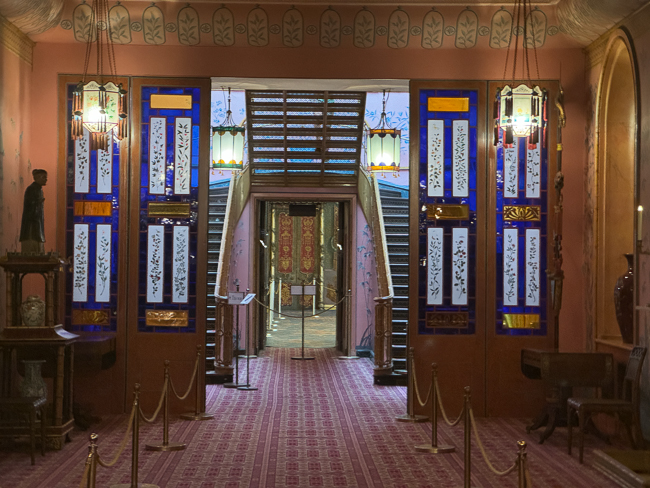
Looking to my right down the long hall at the stairway
 *
*
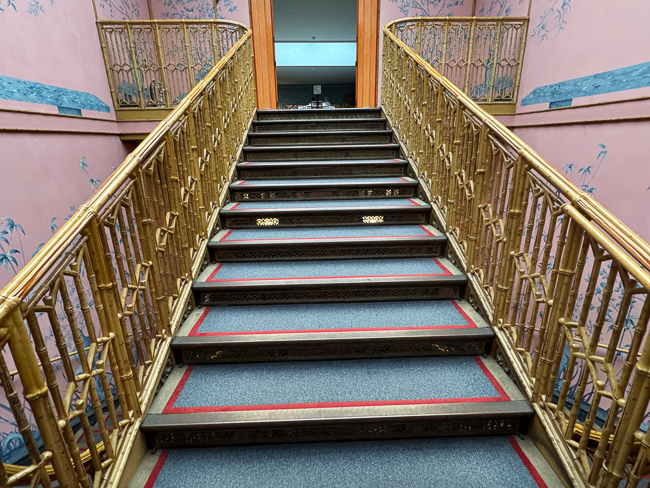
The stairway at the end of the long hall

The stair rail is cast iron painted to look like bamboo.
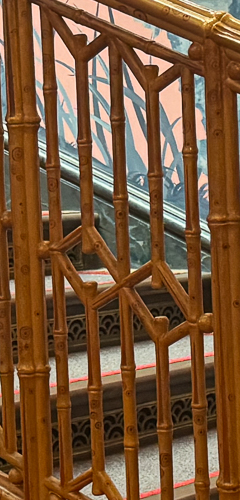
*

An actual bamboo set in a side cutout of the long hall
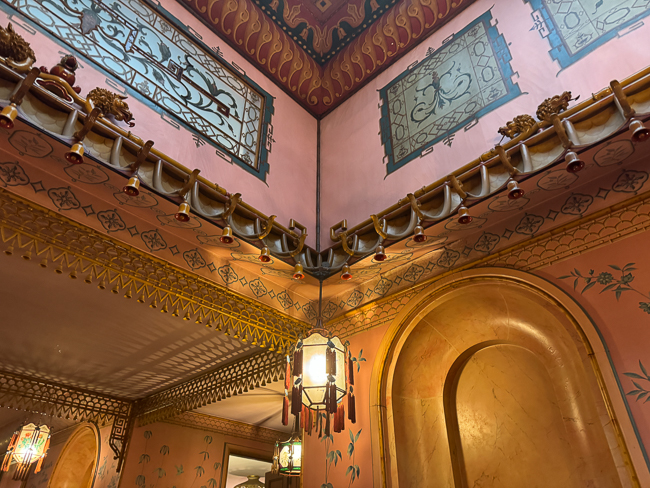
Looking up in the long hallway at little bells everywhere
The Dining Room
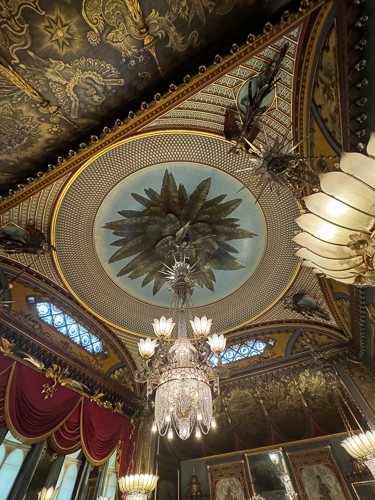
the center of the ceiling in the dining room atop the chandelier is a dragon
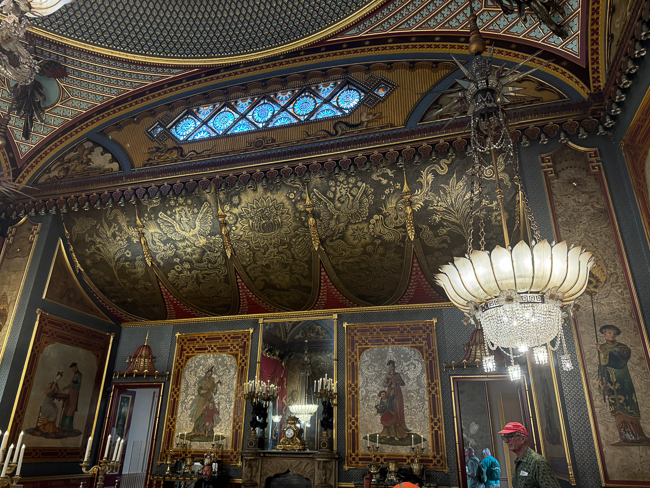
The coping of the dining room
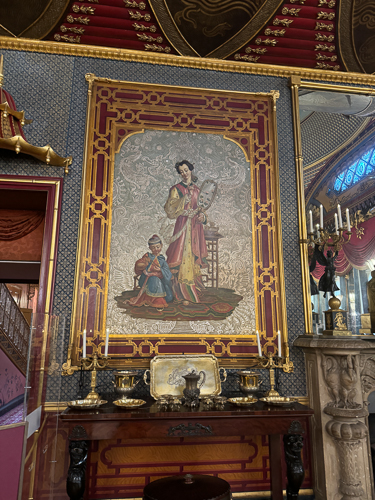
Chinoiserie paintings can be found throughout the house.
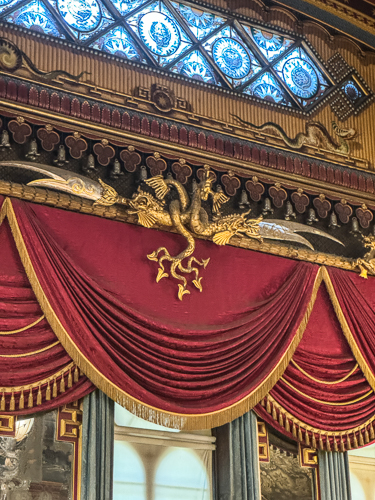
A phantasmagorical figure of a dragon, swords, and fish?
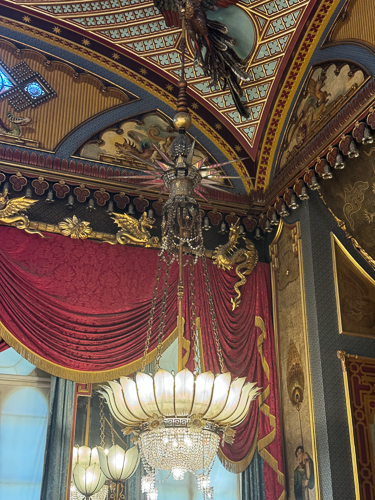
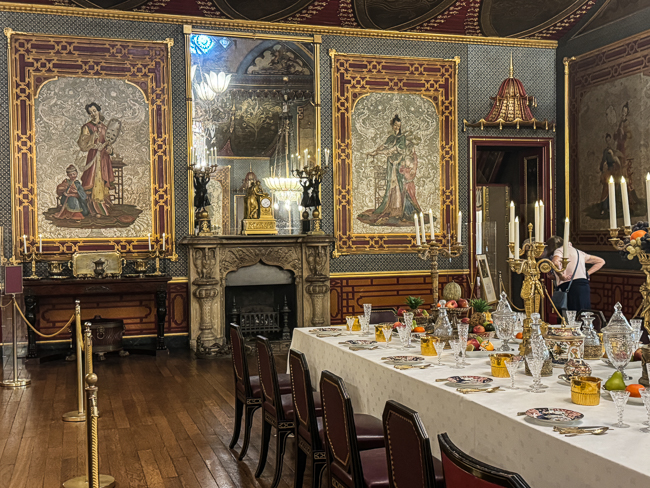
The gold cup-like items at each place setting on the table are used to cool your wine glass. They would be filled with ice, and one would place an empty glass – rim side down – to cool the glass and signal that one needed a top-off.
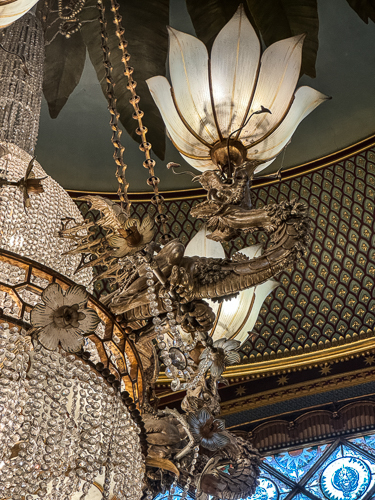
More dragons
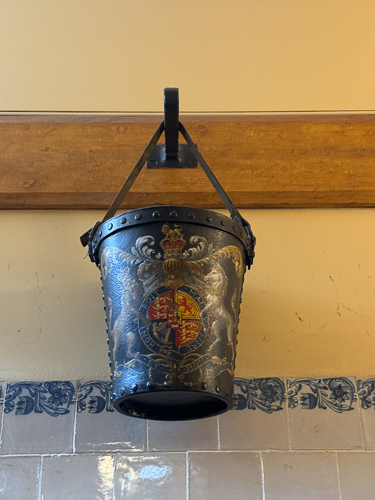
Leaving the dining room, you can find a fire bucket with the royal seal in the hallway.
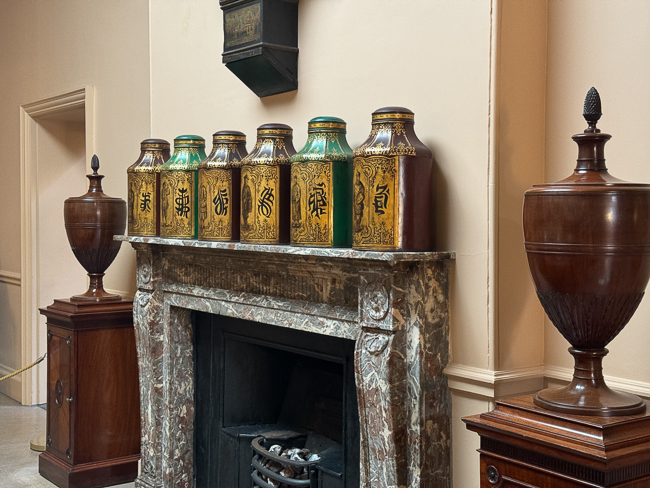
The tea in one of many areas one could consider a butler’s pantry
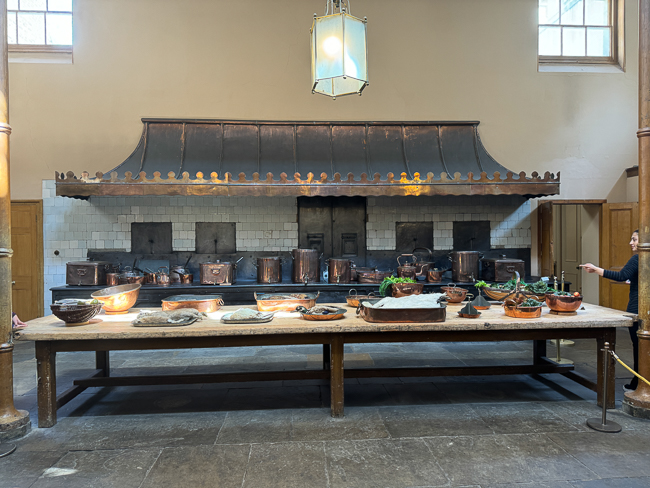
The kitchen stove was so modern as to be heated with steam

When the architect John Nash showed George IV the plans, George IV was bothered by the poles in the middle of the kitchen. Nash said, just wait and see. It is reported George IV cried when he saw how beautiful the kitchen was.
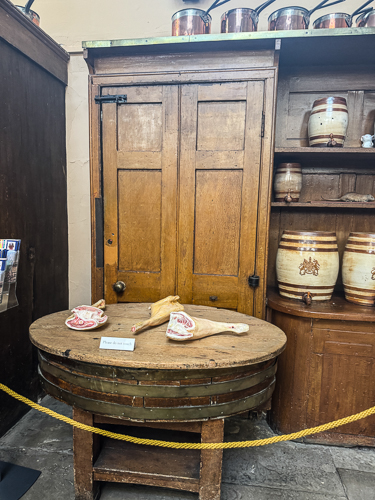
George IV was very generous, and the door behind the round table opened to the exterior, where leftover food was given to the public.

A garbage bin for the stinky stuff such as fish bones
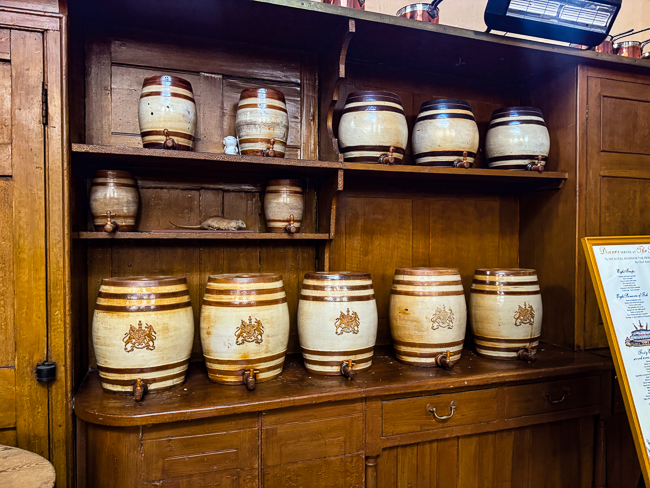
Containers for vinegar and beer
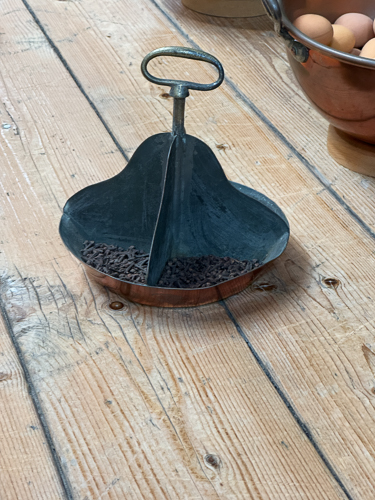
The chef’s herb basket. There were many of these around the room.
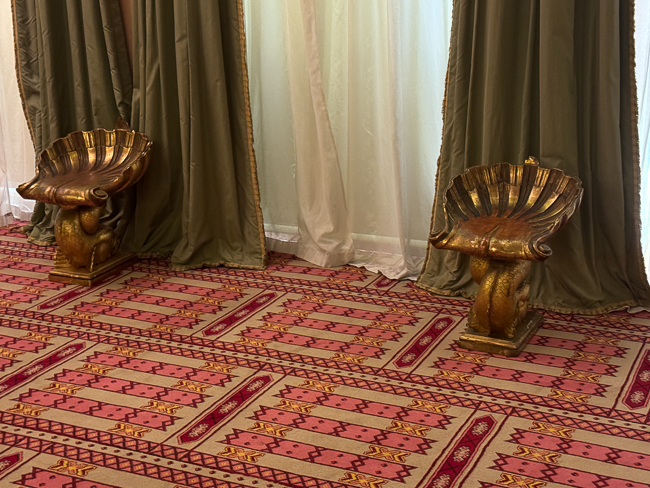
Interesting chairs in one of the sitting rooms

Another clever disguise of a structural beam
The Saloon
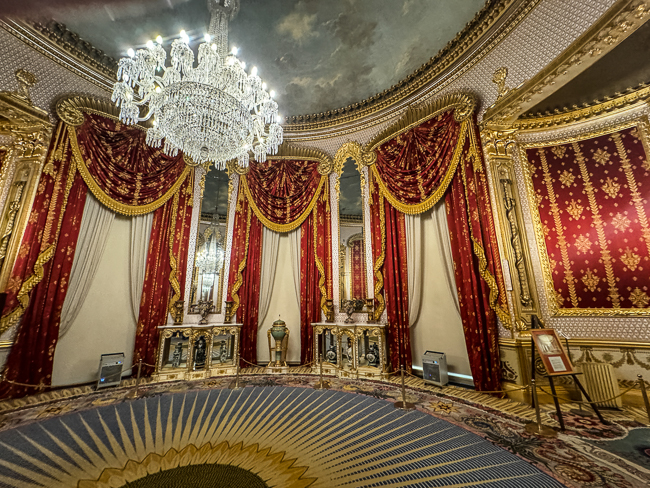
The Saloon
The Saloon is one of the oldest surviving parts of the Royal Pavilion and the most breathtaking room in the palace. It was designed as a formal reception room, where George would greet his guests and accompany them to dinner in the Dining Room. It was designed to make an impression, and boy does it.

When I first entered, my eye was drawn to the carpet. It is one of the most lavish and complicated ever woven by 250-year-old Axminster Carpets, which holds a Royal Warrant. The design incorporates 20 dragons, 100 sun rays, and 274 lotus leaves. The original carpet cost £620 to produce. What is in the room now was designed to cope with the tourism traffic. It cost £59,500 and took fleece from 80 Cheviot, Blackface, Welsh, and Heavy X-bred sheep to produce.
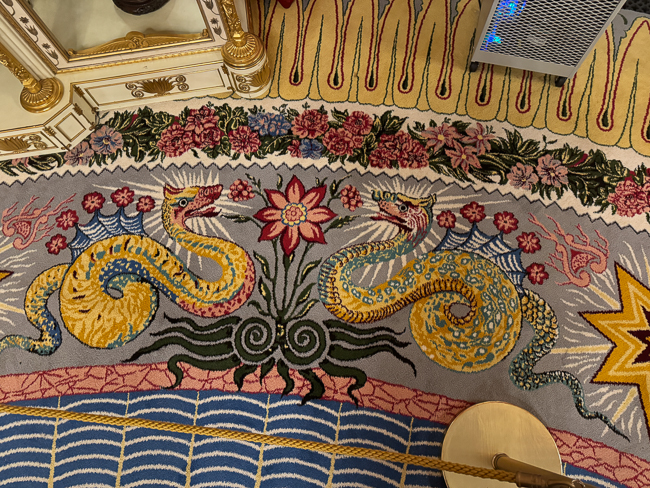
*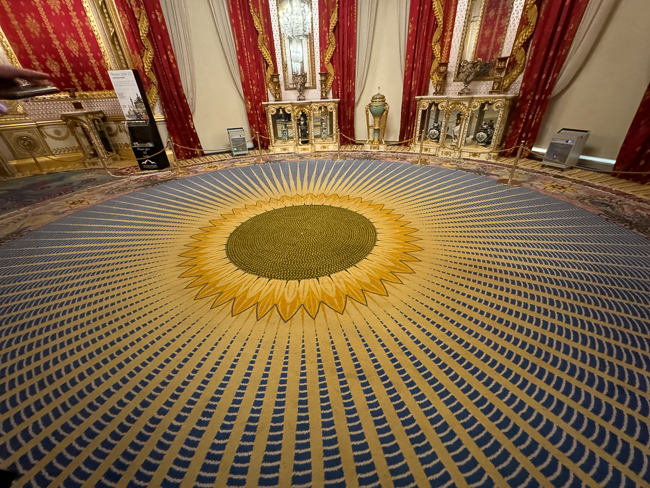
*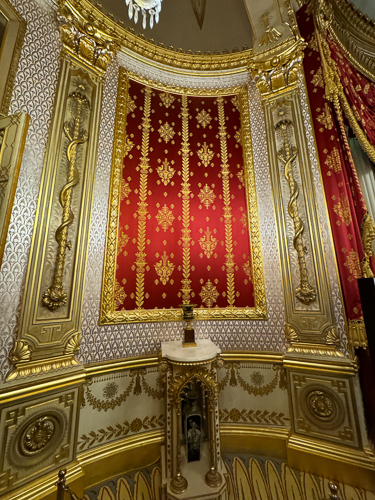
The Music Room
The Music Room features rich, hand-painted red and gold canvases, silvered dragons, chandeliers inspired by lotus plants, and an intricate gilded ceiling.
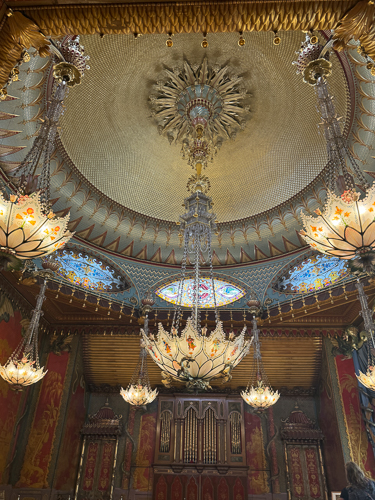 *
*
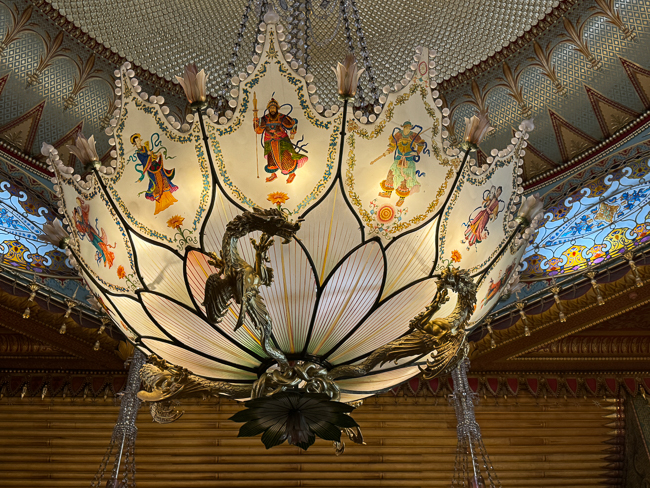
*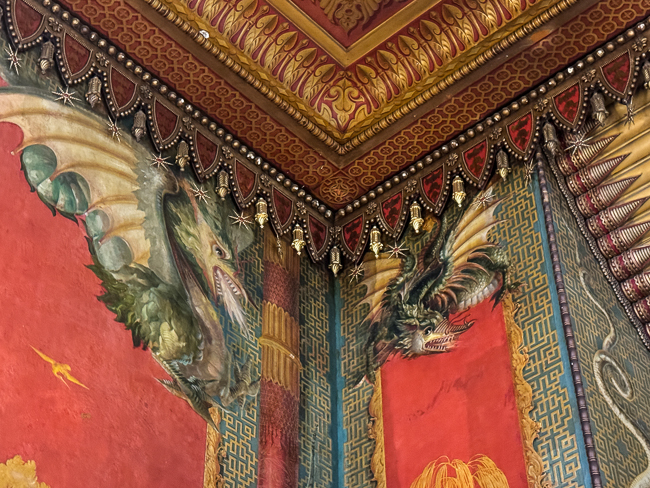
*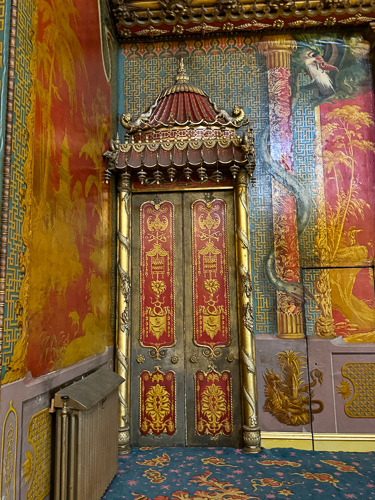
*

The organ in the Music Room is a copy. It was made by Henry Cephas Lincoln and commissioned by George IV in 1818. At the time, it was said to be the largest and most powerful instrument in England. When Queen Victoria sold the Royal Pavilion in 1850, the organ was packed up in 56 pieces and stored. It is now in the new ballroom at Buckingham Palace.
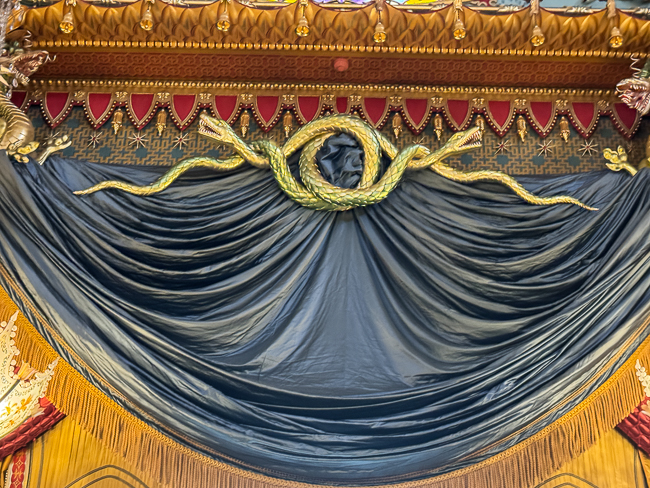
*
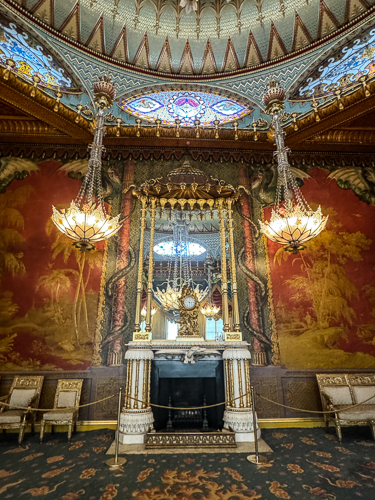
The Music Room Fireplace

Another dragon, this one on the fireplace
The Kings Bedroom
Due to the King’s obesity and subsequent issues, such as gout, he was unable to make it to his upstairs bedroom. A bedroom and sitting room were created on the first floor for his use.
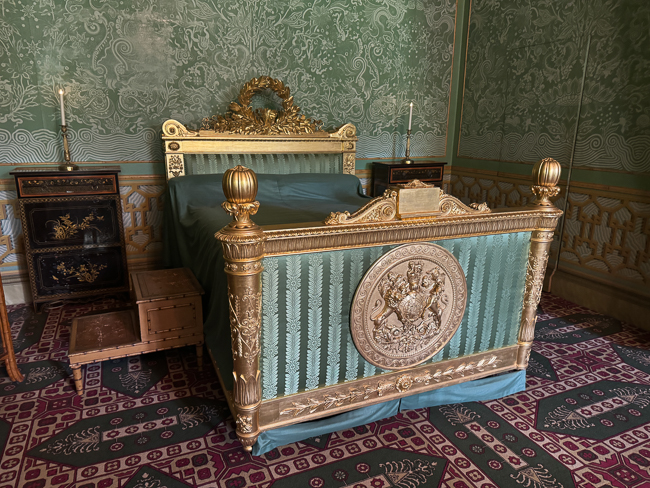
The Kings Bed with stairs
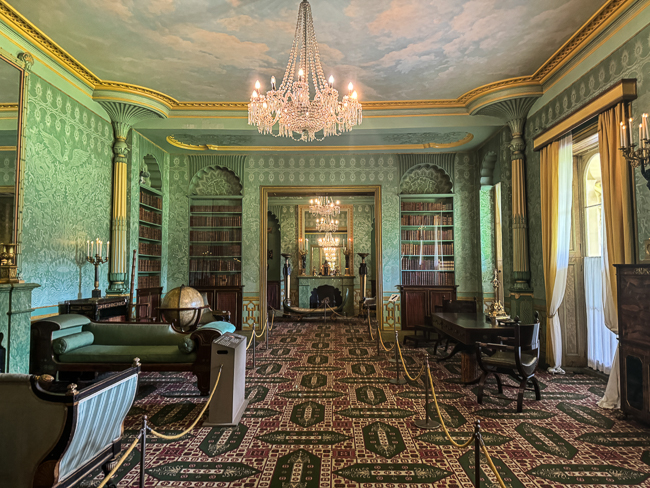
The sitting room off of the Kings bedroom
Throughout the house
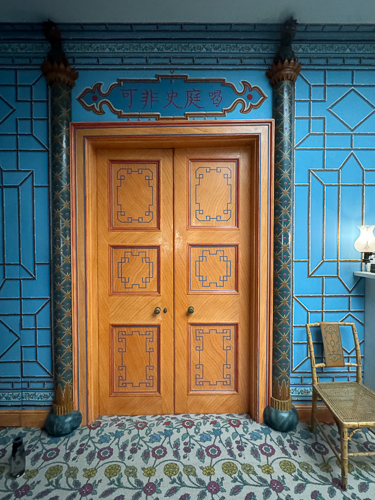
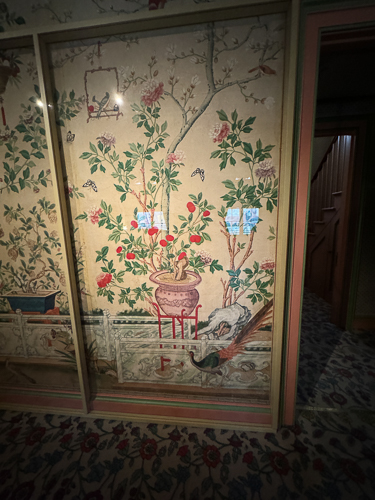
This early 19th-century Chinese Export paper originally hung on the first floor of the Royal Pavilion in Brighton. Queen Victoria removed it and took it to Buckingham Palace. Sections of the set were returned to Brighton and reinstalled in the 1920s.
This jasmine-yellow, hand-painted wallpaper depicting many kinds of colored birds was supplied in 1817 by Frederick Crace for the Saloon at the Royal Pavilion. The Crace ledgers described it as a ‘very fine set of India Paper, green ground, colored flowers, birds, etc.’
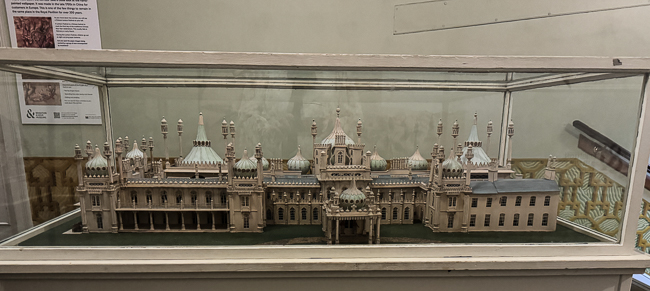
A model of what the Royal Pavillion looked like in the time of George IV
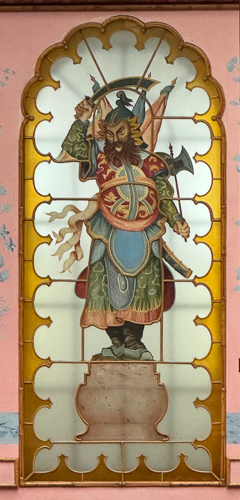
A chinoiserie window showing the Chinese influence with a Western face.
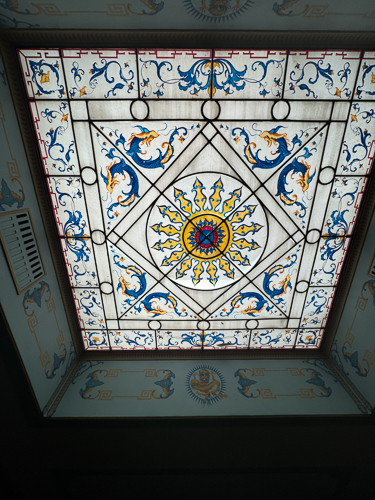 * *
* *
*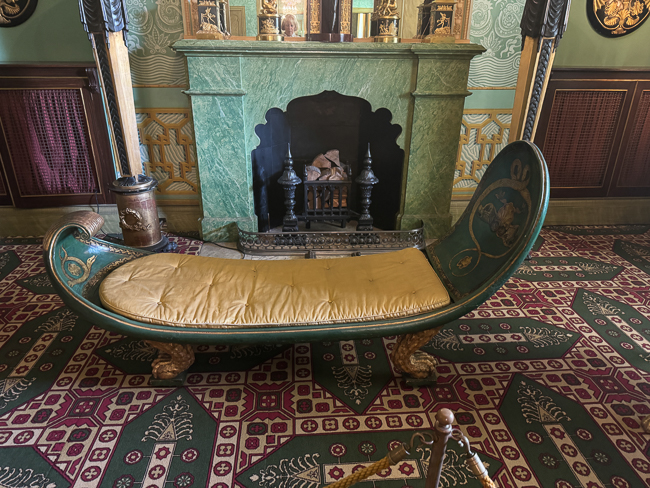
*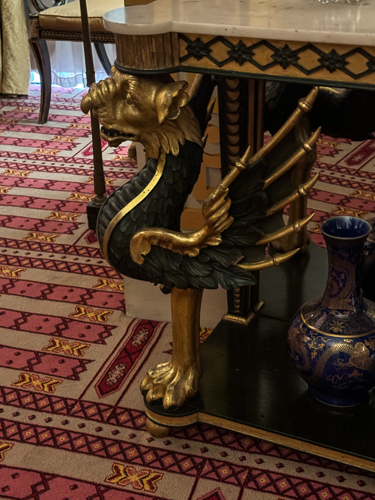
*
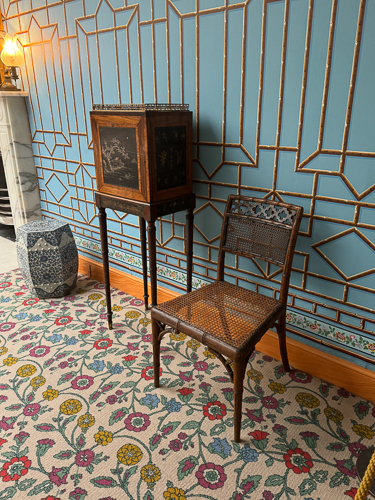
A curiosity cabinet for displaying interesting items in the breakfast room
Many of the fantastic things you see in Brighton are multiplied exponentially in the East Wing of Buckingham Palace. However, the opportunity to take photographs and talk with the most knowledgeable docents you will ever encounter makes Brighton a must!
The Town of Brighton
No longer the Victorian Seaside town of Hercule Poirot, Brighton still has a pier and a vibrant, LGBTQ-friendly community.
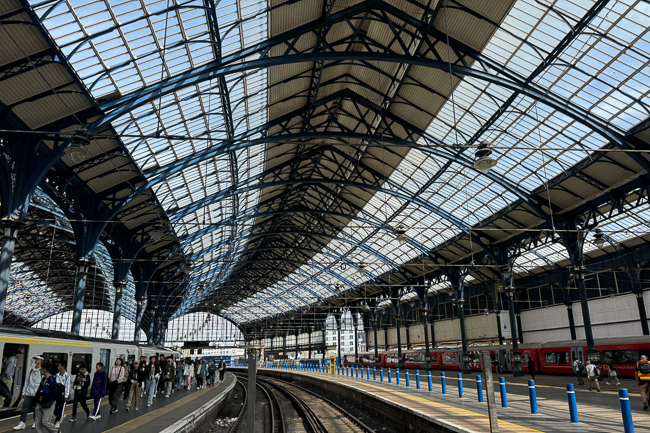
The stunning train station of Brighton was built by the London & Brighton Railway in 1840–41. The platform was built by John Urpeth Rastrick and consists of four pitched roofs, each 250 ft long
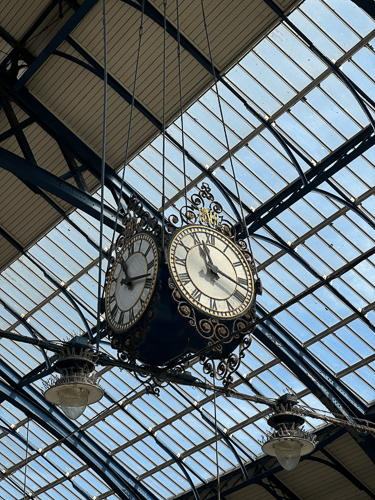
The clock at the rail station
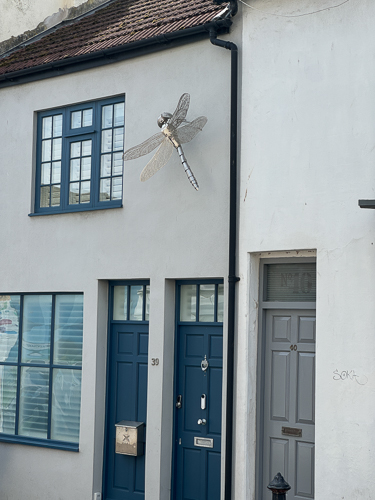 *
*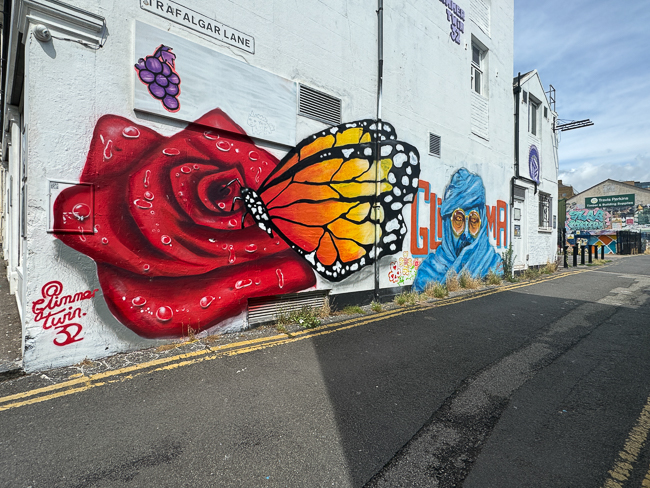
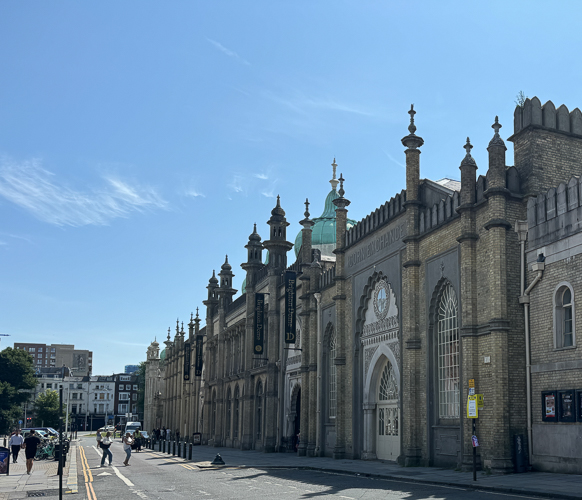
The Brighton Dome is now an entertainment center where ABBA made their debut. It was once part of the Pavillion, serving mainly as back-of-the-house spaces.
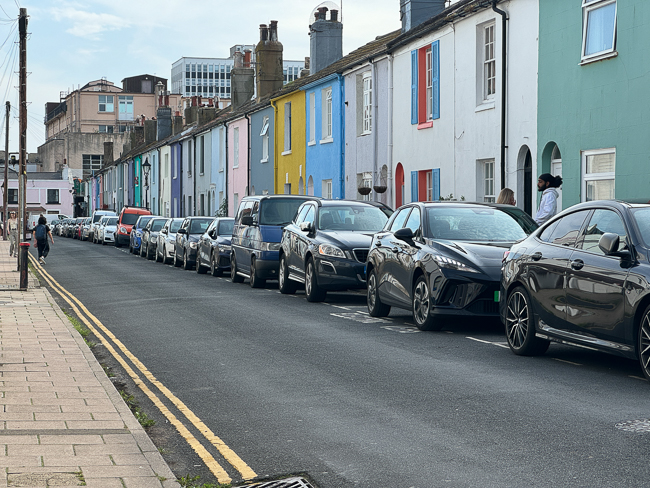 The pier is what one has come to expect in the twentieth century: fast food, trinkets, and carnival games.
The pier is what one has come to expect in the twentieth century: fast food, trinkets, and carnival games.
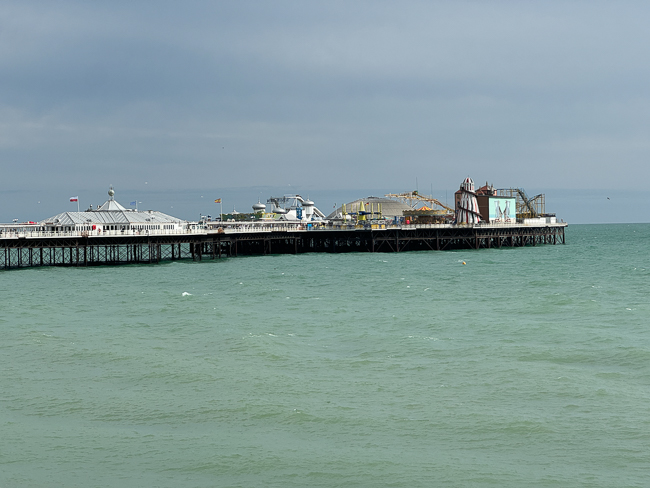
I do recommend a tour of the East Wing of Buckingham Palace, but if that is not in the cards, a day in Brighton is a joy.